-
-
 Energy and Climate Databases
Energy and Climate Databases- The most comprehensive and up-to-date annual energy database.
- Monitoring of technology providers in H2 supply chain.
- Monthly energy data on key energy markets.
- The most reliable and up-to-date power generation database.
- The essentials of LNG trade at your fingertips.
- Global monitoring of new and existing refineries.
- Analyse energy consumption and efficiency trends at world level. Benchmark countries.
- Have your database developed by a recognised expert of both energy and IT.
-
 Energy - Climate Forecasts
Energy - Climate Forecasts- Instant access to energy and emissions forecasts.
- Strategic, annual wholesale price projections backed by Enerdata's energy modelling expertise and our globally recognised POLES model.
- Wedges module showing a breakdown of the levers enabling to reduce emissions between two scenarios.
- Unique, independent projections of consumption by end-use.
- GHG Marginal Abatement Cost Curves.
- Benefit from proven models to draw your own energy scenarios and anticipate tomorrow’s challenges.
-
 Market Intelligence
Market Intelligence- 110 Energy and climate country reports
- A newsletter to receive the latest updates on evolving technologies and policies.
- Global energy news and analyses curated daily.
- Enerdata’s experts bring you the essentials about your market and competitors.
-
-
-
 Market Analysis
Market Analysis- Understanding key consumption trends and drivers across sectors.
- Granular and exclusive insight to address the most pressing business and strategic issues.
- Expertise in strategic and business intelligence, with fine-tuning to the market’s specificities.
-
 Energy - Climate Scenarios
Energy - Climate Scenarios- Providing the outlook of an energy commodity in mid to long term time horizons.
- Sector and driver specific energy demand forecasting.
- Assess the evolution of energy prices on the international and regional markets, as well as end-users prices.
- Enerdata guides you through pathways to reach climate targets.
- Supporting local authorities in their decarbonisation strategies.
-
 Climate Strategy and Policy Evaluation
Climate Strategy and Policy Evaluation- Cutting-edge quantitative tools and relevant indicators to monitor and evaluate evolutions on worldwide energy markets.
- Analysis of the most cost-effective options to reduce emissions.
- Quantified simulation and analysis of pledges for climate change negotiations.
- Breakdown of carbon markets and evaluation of the climate change impacts on the carbon price.
- Enerdata guides you on the most beneficial policy or investment options.
- Turning climate objectives into concrete action plans.
-
 Training
Training- Understand different policy targets and measures on energy efficiency.
- How to measure energy savings?
- Energy Forecasting is a 2 days training to learn to design and interpret energy forecasts.
- Energy statistics training allowing to create energy balance with supply, transformation and consumption and understanding the international energy statistics regulations.
- Initiation to EnerMED level 1is the training to approach on the most powerful energy demand forecasting model.
-
-
Resource Centre
Ireland Key Figures
- Population:
- 5.15 million
- GDP growth rate:
- -3.2 %/year
- Energy independence:
- 21.1%
Data of the last year available: 2023
- Total consumption/GDP:*
- 38.6 (2005=100)
- CO2 Emissions:
- 6.02 tCO2/capita
- Rate of T&D power losses:
- 7.50%
* at purchasing power parity
View all macro and energy indicators in the Ireland energy report
Ireland Energy News
View all news, archive your new and create your own daily newsletters only on your topics/countries of interest with Key Energy Intelligence
Ireland Energy Research
Benefit from up to 2 000 up-to-date data series for 186 countries in Global Energy & CO2 data
A data overview is available in the global energy statistics app
Ireland Total Energy Consumption
In 2023, consumption per capita was 2.6 toe (down from 3.2 toe in 2010) and 7% below the EU average. Per capita electricity consumption was almost 6100 kWh in 2023, 13% above the EU average.
Graph: CONSUMPTION TRENDS BY ENERGY SOURCE (Mtoe)
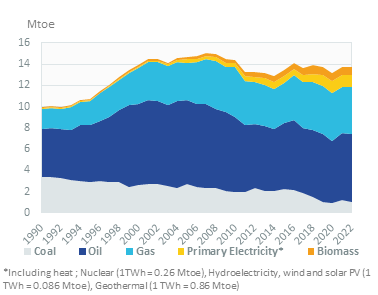
Interactive Chart Ireland Total Energy Consumption
Benefit from up to 2 000 up-to-date data series for 186 countries in Global Energy & CO2 data
View the detailed fondamentals of the market at country level (graphs, tables, analysis) in the Ireland energy report
Ireland Crude Oil Production
There is currently no oil production. Providence Resources was the first company to report commercially viable oil flow from its Barryroe well in 2012.
Ireland imports all its crude oil and about 90% of its refined product needs. Ireland's oil dependency is among the highest in the EU.
Ireland has just one oil refinery, the Whitegate refinery located in Cork, with a capacity of 75 kb/d. It processes crude, mainly sourced from the North Sea, North Africa, and West Africa.
Interactive Chart Ireland Crude Oil Production
Benefit from up to 2 000 up-to-date data series for 186 countries in Global Energy & CO2 data
Additionally, for more detailed information on refineries, you can request a sample of our EMEA Refineries Dataset
Ireland Oil Products Consumption
The consumption of oil products has remained relatively stable since 2013 at around 6 Mt, apart from an 8% drop in 2020. Previously, it decreased rapidly between 2006 and 2013 (-6%/year).
Transport absorbs 61% of oil demand (2023), followed by the residential-tertiary sector (27%) and industry (10%) (including non-energy uses).
Graph: OIL CONSUMPTION (Mt)
5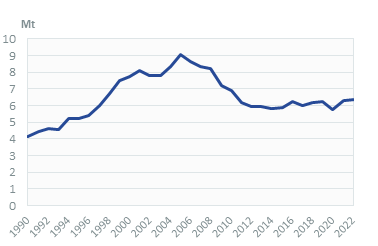
Graph: OIL CONSUMPTION BREAKDOWN BY SECTOR (2023, %)
Interactive Chart Ireland Refined Oil Products Production
Benefit from up to 2 000 up-to-date data series for 186 countries in Global Energy & CO2 data
Additionally, for more detailed information on refineries, you can request a sample of our EMEA Refineries Dataset
Ireland Natural Gas Consumption
Natural gas decreased by 20% in 2023, continuing its downward trend (-5% in 2021. It rose between 2016 and 2020 (+1.9%/year), after a 16% rebound in 2015. It decreased sharply (-5.5%/year) between its peak level in 2010 at 5.5 bcm and 2014, as a result of a reduction in power generation from gas (-10%/year).
Graph: NATURAL GAS CONSUMPTION (bcm)
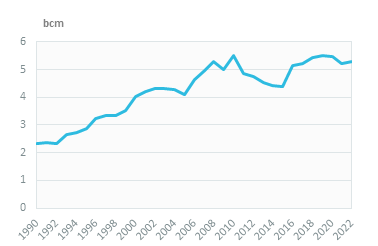
Interactive Chart Ireland Natural Gas Domestic Consumption
Benefit from up to 2 000 up-to-date data series for 186 countries in Global Energy & CO2 data
Additionally, for more detailed information on the LNG trade, you can request a sample of our EMEA LNG Trade Dataset
Ireland Coal Consumption
The consumption of coal and peat dropped from 6 Mt in 2016 to 1.5 Mt in 2023 (-75%).
Graph: COAL CONSUMPTION (Mt)
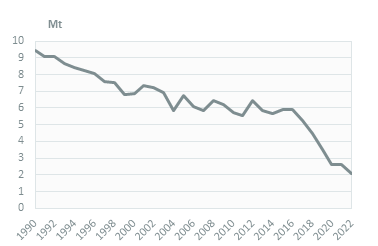
The electricity sector absorbs 50% of coal and peat consumption (down from 61% in 2022), followed by the residential-tertiary sector with 36%.
Graph: COAL CONSUMPTION BREAKDOWN BY SECTOR (2023, %)
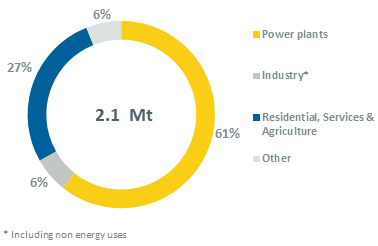
Interactive Chart Ireland Coal and Lignite Domestic Consumption
Benefit from up to 2 000 up-to-date data series for 186 countries in Global Energy & CO2 data
View the detailed consumption trends at country level (graphs, tables, analysis) in the Ireland energy report
Ireland Power Consumption
Electricity consumption has increased by 2.2%/year since 2014, reaching 31.5 TWh in 2023. It decreased between 2008 and 2012 (-2.3%/year), driven by the economic crisis.
Graph: ELECTRICITY CONSUMPTION (TWh)

Services are the largest electricity consumers with 48%, followed by households (27%) and industry (21%) (2023).
Graph: ELECTRICITY CONSUMPTION BREAKDOWN BY SECTOR (2023, %)
Ireland Renewable in % Electricity Production
SEAI is also the agency in charge of the implementation of the renewable energy policy.
Interactive Chart Ireland Share of Renewables in Electricity Production (incl hydro)
Benefit from up to 2 000 up-to-date data series for 186 countries in Global Energy & CO2 data
Learn more about renewables in the European Battery Market Analysis
Ireland CO2 Fuel Combustion/CO2 Emissions
In 2023, GHG emissions decreased by 4% to 61 MtCO2e (including LULUCF). This is the lowest level in three decades and below the 1990 baseline. In 2022, GHG emissions decreased by 9%, reaching 63 MtCO2. In 2021, emissions had increased by 5% in 2021 to 69.4 MtCO2, 12% above their 1990 level. Emissions decreased by 2.7%/year between 2017 and 2020; previously, they had been increasing by 1.6%/year since 2012. These emissions fell by 15%, from their 2005 peak level of 78 MtCO2 to 65 MtCO2 in 2012, because of the economic crisis.